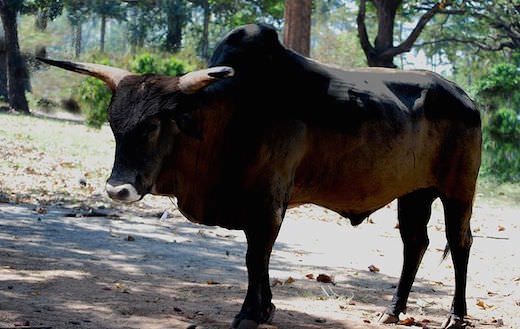Aurochs

Extinct 1627
Only becoming extinct in 1627, the aurochs is unique in regard to post glacial mega-fauna such as woolly rhinoceri, mammoths and sabre toothed big cats, in that the species survived much further in to recorded human history. Indeed, separated in extinction by only thirty five years from the dodo, the aurochs lasted in Europe, Eurasia, North Africa and even some parts of the Middle East, long enough for attempts at domestication to be made.
Moreover, with the aurochs being the ancestor of today's modern cattle, a favorite battle beast in the gladiatorial arenas of ancient Rome, and even a thirteenth century protected hunting animal, the species has had more of an immediate impact on human society than many might first think.
Varying in size from shoulder heights of 180cm to 150cm, the aurochs was one of the largest post glacial herbivores. Similar in appearance but much more formidable in size to modern day bovines, aurochs' most distinctive features were their size, strongly expressed neck and shoulders, and markedly elongated frontal bones necessary in order for the aurochs to wield horns which could grow up to 80cm in length and 20cm in diameter.
Conversely however, it is precisely man's lengthy and relatively recent co-survival alongside the aurochs that has lead to there being no present consensus on the animal's original natural habitat. While it is generally agreed that the aurochs first evolved to suit wide open grassland areas during the Pleistocene, the animal was soon after forced to share the land with man. This being the case, while Middle Eastern aurochs were already being domesticated by 6000BC, the aurochs in Europe and Eurasia were in many cases already decreasing in size to suit more restrictive habitats than they might arguably have roamed naturally.
Comparisons of isotopes in aurochs and domestic cattle bones have however, been able to determine that while definitely a herd and grazing animal, the aurochs actually preferred much wetter terrain than modern cattle. Some have therefore speculated that in Europe especially there may have originally been an ecological separation between the preferred habit of aurochs and that of the then competing species the European bison. Where bison roamed the drier forests and open plains of Europe, the aurochs, it has been speculated, was consigned due to competition to Europe's wetter forests and deltas.
Population Distribution
As for the aurochs' extinction, the species was arguably one of the first which mankind actually made efforts to preserve and protect. Popularly hunted and domesticated by everyone from the Romans to the Greeks and Ottomans, the aurochs by the fith century BC had already largely disappeared from Greece and Eurasia. The aurochs' last strong holds then, were centered around Poland, East Prussia, Romania, Lithuania and Moldova, where hunting aurochs was restricted to noble families and royalty. However, despite the royal houses of the aforementioned territories going so far as to assign gamekeepers to provide grazing areas for aurochs, by 1564 European gamekeepers knew of only 38 surviving animals in their care.
With however, the last known female aurochs dying in Poland in 1627, it is now widely accepted that restrictive territory brought about by Europe's agricultural revolutions and susceptibility to diseases contracted from by then domestic cattle herds played just as much a part in the species' extinction as successive centuries of unrestricted hunting.